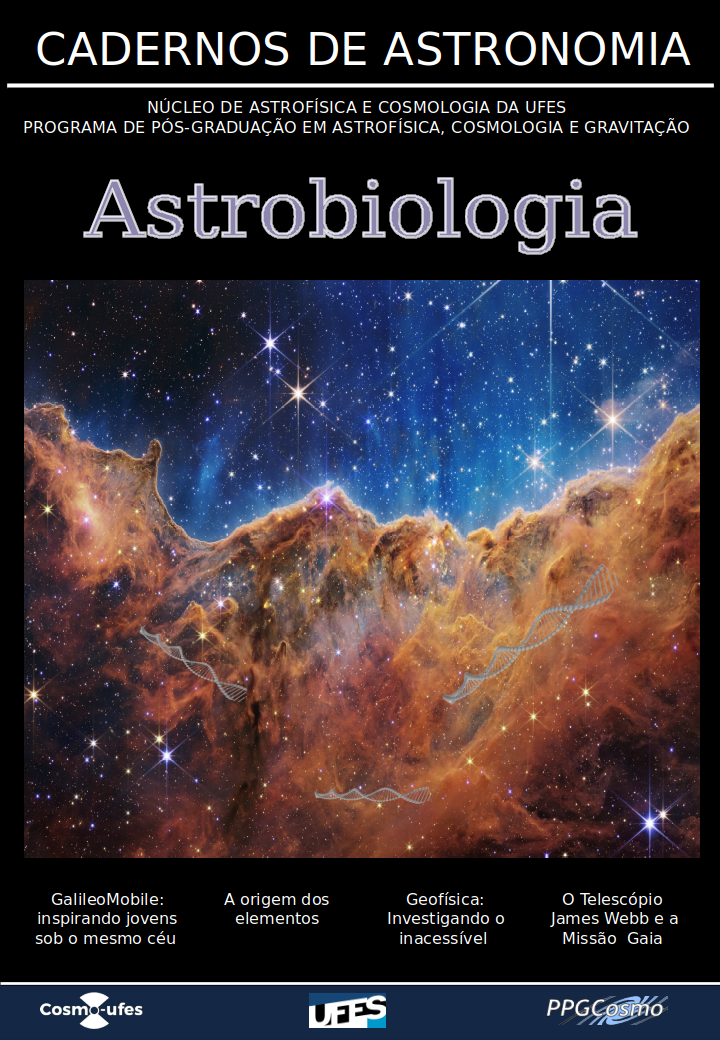Um critério energético para o desenvolvimento de vida em um exoplaneta
DOI:
https://doi.org/10.47456/Cad.Astro.v3n2.38561Palabras clave:
astrobiologia, exoplanetas, desenvolvimento da vidaResumen
Este artigo faz uma revisão da hipótese PET (Proportional Evolutionary Time), recentemente proposta na literatura. Esta proposta sugere uma relação entre a quantidade máxima de energia incidente na superfície de um exoplaneta com o tempo necessário para o desenvolvimento de vida complexa. Como consequência, pode-se sugerir também uma relação entre a classificação espectral da estrela hospedeira e a probabilidade de que um de seus exoplanetas tenha atendido as condições energéticas para o desenvolvimento de vida. Além de apresentar esta hipótese, discutimos algumas possíveis extensões e aplicações. Como exemplo de um de nossos resultados, encontramos que já houve incidência energética suficiente no planeta Vênus capaz de viabilizar o desenvolvimento de vida complexa. O mesmo ainda não teria ocorrida em Marte. Também encontramos um possível contra-exemplo da hipótese PET. O exoplaneta GJ 887 b orbita uma estrela tipo M e recebeu energia suficiente para desenvolver vida complexa.
Referencias
J. A. de Freitas Pacheco, Vida no Universo (EDUSP, São Paulo, 2020).
E. A. Bell et al., Potentially biogenic carbon preserved in a 4.1 billion-year-old zircon, Proceedings of the National Academy of Sciences 112(47), 14518 (2015).
P. Ward e D. Bronnlee, Rare Earth: Why Complex Life Is Uncommon in the Universe (Copernicus books, New York, 2003).
J. Haqq-Misra, R. K. Kopparapu e E. T. Wolf, Why do we nd ourselves around a yellow star instead of a red star?, International Journal of Astrobiology 17(1), 77-86 (2018).
J. Haqq-Misra, Does the evolution of complex life depend on the stellar spectral energy distribution?, Astrobiology 19(10), 1292 (2019).
D. O. Gough, Solar Interior Structure and Luminosity Variations, Solar Physics 74(1), 21 (1981).
I. Baraffe et al., New evolutionary models for pre-main sequence and main sequence low-mass stars down to the hydrogenburning limit, Astronomy & Astrophysics 577, A42 (2015).
D. Schulze-Makuch et al., A two-tiered approach to assessing the habitability of exoplanets, Astrobiology 11(10), 1041 (2011).
D. Souto et al., Stellar and planetary characterization of the ross 128 exoplanetary system from APOGEE spectra, The Astrophysical Journal 860(1), L15 (2018).
Descargas
Publicado
Número
Sección
Licencia
Derechos de autor 2022 Hermano Velten, Douglas Delladea, Arthur Primola

Esta obra está bajo una licencia internacional Creative Commons Atribución 4.0.






